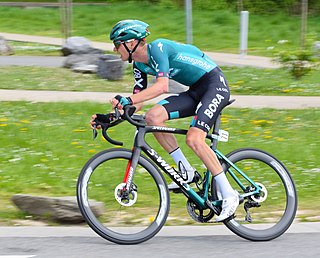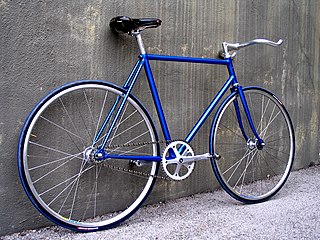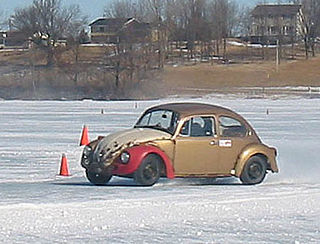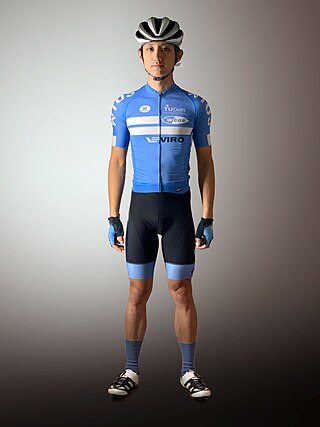Related Research Articles

A bicycle, also called a pedal cycle, bike, push-bike or cycle, is a human-powered or motor-powered assisted, pedal-driven, single-track vehicle, having two wheels attached to a frame, one behind the other. A bicycle rider is called a cyclist, or bicyclist.

Cycling, also known as bicycling or biking, is the activity of riding a bicycle or other type of cycle. It encompasses the use of human-powered vehicles such as balance bikes, unicycles, tricycles, and quadricycles. Cycling is practised around the world for purposes including transport, recreation, exercise, and competitive sport.

Critical Mass started as a cyclist movement, back in 1992, in San Francisco. Today it is a form of direct action in which people meet at a set location and time and travel as a group through their neighbourhoods on bikes. The idea is for people to group together to make it safe for each other to ride bicycles through their streets, based on the old adage: there's safety in numbers.

The Race Across America, or RAAM, is an ultra-distance road cycling race held across the United States that started in 1982 as the Great American Bike Race.

Road cycling is the most widespread form of cycling in which cyclists ride on paved roadways. It includes recreational, racing, commuting, and utility cycling. As users of the road, road cyclists are generally expected to obey the same laws as motorists, however there are certain exceptions. While there are many types of bicycles that are used on the roads such as BMX, recumbents, racing, touring and utility bicycles, dedicated road bicycles have specific characteristics that make them ideal for the sport. Road bicycles have thinner tires, lighter frames with no suspension, and a set of drop handle bars to allow riders to get in a more aerodynamic position while cycling at higher speeds. On a flat road, an intermediate cyclist can average about 18 to 20 mph, while a professional rider can average up to 25 mph (40 km/h). At higher speeds, wind resistance becomes an important factor; aerodynamic road bikes have been developed over the years to ensure that as much as possible of the rider's energy is spent propelling the bike forward.

A fixed-gear bicycle is a bicycle that has a drivetrain with no freewheel mechanism such that the pedals always will spin together with the rear wheel. The freewheel was developed early in the history of bicycle design but the fixed-gear bicycle remained the standard track racing design. More recently the "fixie" has become a popular alternative among mainly urban cyclists, offering the advantage of simplicity compared with the standard multi-geared bicycle.

Bicycle culture can refer to a mainstream culture that supports the use of bicycles or to a subculture. Although "bike culture" is often used to refer to various forms of associated fashion, it is erroneous to call fashion in and of itself a culture.

Ice racing is a form of racing that uses cars, motorcycles, snowmobiles, all-terrain vehicles, or other motorized vehicles. Ice racing takes place on frozen lakes or rivers, or on groomed frozen lots. As cold weather is a requirement for natural ice, it is usually found at higher latitudes in Canada, the northern United States, and in northern Europe, although limited indoor events are held in warmer climates, typically on ice hockey rinks. Tracks in North America vary from 1/4 mile to several mile-long circuits.

Bicycle commuting is the use of a bicycle to travel from home to a place of work or study — in contrast to the use of a bicycle for sport, recreation or touring.

Vehicular cycling is the practice of riding bicycles on roads in a manner that is in accordance with the principles for driving in traffic, and in a way that places responsibility for safety on the individual.

Since the advent of the bicycle in the 1860s, Chicago has been distinguished as one of the premier cycling locations in the United States, with such public cycling destinations as Grant Park, Burnham Park and the Chicago Park District's Lakefront Trail.

This is a glossary of terms and jargon used in cycling, mountain biking, and cycle sport.

Mixed terrain cycle touring is the practice of cycling over a variety of surfaces and topography on a single route, with a single bicycle. The recent popularity of mixed terrain touring is in part a reaction against the increasing specialization of the bike industry.

Cycling in Canada is experienced in various ways across a geographically huge, economically and socially diverse country. Among the reasons for cycling in Canada are for practical reasons such as commuting to work or school, for sports such as road racing, BMX, Mountain bike racing, freestyle BMX, as well as for pure recreation. The amount and quality of bicycle infrastructure varies widely across the country as do the laws pertaining to cyclists such as bicycle helmet laws which can differ by province.

Cycling in Atlanta has grown in popularity in recent years, from 0.33% of commutes in 2000 to 1.1% in 2009, aided by improving cycling infrastructure and community support. Although Atlanta has historically been a city defined by the automobile, its increasingly compact urban form and mild climate are encouraging residents to cycle to work, shopping, and recreational destinations. Though Atlanta's famed hilly topography can make cycling challenging, though fun, many parts of the city are relatively flat, including some of the more densely populated areas. However, heavy automobile traffic, the lack of bike lanes on many streets, and difficulty in crossing major streets deter most residents from cycling frequently in Atlanta.
The Tour Divide is an annual mountain biking ride traversing the length of the Rocky Mountains, from Canada to the Mexican border. Following the 2,745-mile (4,418 km) Great Divide Mountain Bike Route, it is an ultra-distance cycling ride that is an extreme test of endurance, self-reliance and mental toughness. The ride format is strictly self-supported, and it is not a stage race - the clock runs continuously from the start until riders cross the finish line, usually more than two weeks later.

Cold-weather biking, cold-weather cycling, or winter biking is the use of a bicycle during months when roads and paths are covered with ice, slush and snow. Cold weather cyclists face a number of challenges in near or below freezing temperatures. Urban commuters on city streets may have to deal with "[s]now, slush, salt, and sand", which can cause rust and damage to metal bike components. Slush and ice can jam derailleurs. Some cyclists may bike differently in winter, by "slow[ing] down on turns and brak[ing] gradually" in icy conditions. Gaining traction on snow and ice-covered roads can be difficult. Winter cyclists may use bikes with front and rear fenders, metal studded winter tires and flashing LED lights. Winter cyclists may wear layers of warm clothes and "ea[r], face, and han[d]" coverings may be used. Specialized winter bikes called fatbikes, which have wide, oversized tires that are typically inflated with low pressure, are used in snow trail riding and winter bike competitions.

San Jose, California has various cycling routes on roads and trails used by both commuters and recreational riders. The city has plans to expand the current 285 miles (459 km) of bike lanes to 400 miles (640 km), and the current 60 miles (97 km) of trails to 100 miles (160 km). San Jose was ranked as a bronze-level bicycle-friendly community by the League of American Bicyclists.

Gravel cycling, gravel biking or gravel grinding is a sport, or a leisure activity, in which participants ride bicycles mostly on gravel roads. Sometimes, specially designed gravel bikes are used; in other cases, any bicycle capable of covering the terrain can be used.

In competitive cycling, the kit is the standard equipment and attire worn specifically by athletes participating in the sport. The outfits differ from the clothes worn in other forms of cycling, such as commuting and recreational cycling. Competitive kit uses technical and performance materials and features to improve efficiency and comfort. The UCI specify the kit and the design the riders use.
References
- ↑ Prendergast, Michael (2013-09-01), A Winter of Cyclists (Documentary, Adventure, Sport), retrieved 2022-09-21
- ↑ "ChainRing Films - A Winter of Cyclists, the Documentary Film". Archived from the original on 2018-08-06. Retrieved 2022-09-21.
{{cite web}}: CS1 maint: bot: original URL status unknown (link) - ↑ Icy Bike Winter Commuting Challenge , retrieved 2022-09-21
- Daily Camera Article on A Winter of Cyclists
- Denver Post Winter Riding Tips